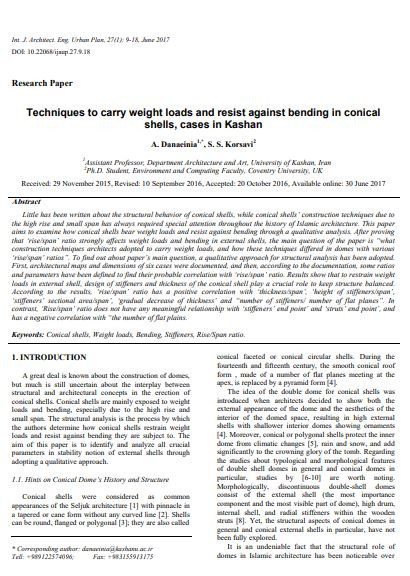
Little has been written about the structural behavior of conical shells, while conical shells’ construction techniques due to
the high rise and small span has always required special attention throughout the history of Islamic architecture. This paper
aims to examine how conical shells bear weight loads and resist against bending through a qualitative analysis. After proving
that ‘rise/span’ ratio strongly affects weight loads and bending in external shells, the main question of the paper is “what
construction techniques architects adopted to carry weight loads, and how these techniques differed in domes with various
‘rise/span’ ratios”. To find out about paper’s main question, a qualitative approach for structural analysis has been adopted.
First, architectural maps and dimensions of six cases were documented, and then, according to the documentation, some ratios
and parameters have been defined to find their probable correlation with ‘rise/span’ ratio. Results show that to restrain weight
loads in external shell, design of stiffeners and thickness of the conical shell play a crucial role to keep structure balanced.
According to the results, ‘rise/span’ ratio has a positive correlation with ‘thickness/span’, ‘height of stiffeners/span’,
‘stiffeners’ sectional area/span’, ‘gradual decrease of thickness’ and “number of stiffeners/ number of flat planes”. In
contrast, ‘Rise/span’ ratio does not have any meaningful relationship with ‘stiffeners’ end point’ and ‘struts’ end point’, and
has a negative correlation with “the number of flat plains.
I agree to the terms outlined below:
You agree to upload and assign Mosqpedia Database the rights to use the content worldwide and in perpetuity across all current and future media platforms. Mosqpedia Database may edit, copy, adapt and translate your contribution.
The content will be distributed under the Creative Commons Attribution-Deed – Attribution-NonCommercial-NoDerivatives 4.0 International – Creative Commons
All data will be stored in line with data protection regulations.